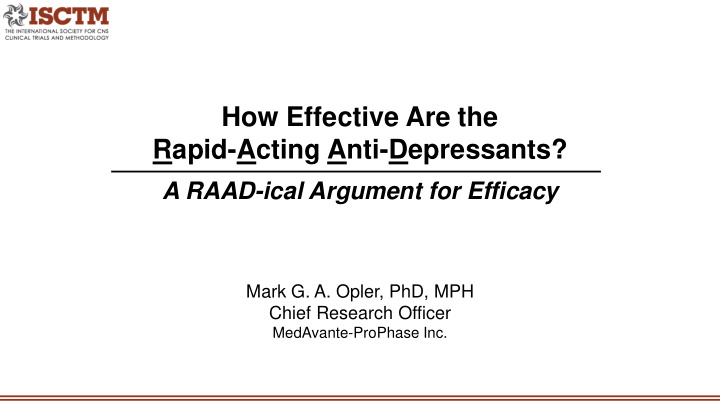



How Effective Are the Rapid-Acting Anti-Depressants? A RAAD-ical Argument for Efficacy Mark G. A. Opler, PhD, MPH Chief Research Officer MedAvante-ProPhase Inc.
Dangerous Street Drugs vs. Miracle Cures
Voice of the Patient …for example, one patient, who had failed to respond to either multiple medication trials or 2 ECT trials, said very calmly 10 minutes after inhaling 40 mg of ketamine, “I am not depressed.” A few minutes later he remarked, “I never noticed how beautiful the sunlight is shining through your drapes,” and asked if I would open the drapes. When I did he said, “That’s beautiful! I never noticed you had a river behind your office.” When the session ended about 45 minutes after he had inhaled ketamine, he said, “I was going to head home, but I think I will go meet some friends. I haven’t seen them in over a year.” From : Opler L, Opler M, and Arnsten A, 2016 Opler, L., Opler, M., & Arnsten, A. (2016). CNS Spectrums, 21(1), 12-22.
Ketamine Efficacy Data, Zarate et al. 2006 “…we also found short-lived perceptual disturbances; such symptoms could have affected study blind. One potential study design … might be to include an active comparator such as intravenous amphetamine, which also produces psychotogenic effects.” From: Zarate et al. Arch Gen Psychiatry. 2006 Aug;63(8):856-64.
Ketamine vs. Midazolam, Murrough et al. 2013 “We designed the present study to test the rapid antidepressant efficacy of ketamine in a relatively large group of subjects with treatment-resistant major depression, using an active placebo control condition (i.e., the anesthetic benzodiazepine midazolam) to optimize blinding and mitigate the influence of nonspecific factors on antidepressant outcome.” From: Murrough et al. Am J Psychiatry. 2013 Oct 1; 170(10): 1134–1142.
Ketamine vs. Midazolam, Murrough et al. 2013 “The use of the anesthetic benzodiazepine midazolam as a control condition is a strength of the current study, although there is likely no perfect control condition for ketamine… Our objective was to select an agent that would function as a placebo yet induce transient psychoactive effects… While the rates of general adverse events were similar across the two conditions, transient dissociative side effects immediately following study drug infusion were higher in ketamine...” From: Murrough et al. Am J Psychiatry. 2013 Oct 1; 170(10): 1134–1142.
IN Esketamine Phase II Efficacy Data From: Daly et al. JAMA Psychiatry. 2018 Feb 1;75(2):139-148
IN Esketamine Phase II CADSS Data From: Daly et al. JAMA Psychiatry. 2018 Feb 1;75(2):139-148
In the absence of dissociation, RAADs still effective On Rapastinel/GLYX-13: “…GLYX-13 did not increase psychotomimetic effects at any time after the dose was administered, unlike what is seen with treatment with ketamine…” From: Preskorn et al. J Psychiatr Pract. 2015 Mar;21(2):140-9
Dissociation and relationship to efficacy “Dissociative side effects… correlated with change in depression on the day of infusion and seven days post-infusion… The present correlation suggests dissociative side effects as a clinical biomarker to predict ketamine’s efficacy.” From: Luckenbaugh et all. J Affect Disord. 2014 Apr; 159: 56–61.
Dissociation does not explain RAAD efficacy “…although statistically significant, the CADSS change from baseline explained only a fraction of the variance in ketamine’s antidepressant response. Thus, it remains unclear whether intra-infusion dissociation is necessary for ketamine’s antidepressant response.” From : Luckenbaugh et all. J Affect Disord. 2014 Apr; 159: 56–61. From: Luckenbaugh et all. J Affect Disord. 2014 Apr; 159: 56–61.
Efficacy evaluation by blinded, independent rater “Independent, blinded, remote raters performed a Montgomery-Asberg Depression Rating Scale (MADRS) assessment during the treatment phase at 24 hours post first dose and weekly thereafter.” From: Popova et al. 2018 Annual Meeting of the American Psychiatric Association (APA), May 8, 2018, New York, NY
Efficacy evaluation by blinded, independent rater From: Popova et al. 2018 Annual Meeting of the American Psychiatric Association (APA), May 8, 2018, New York, NY
Voice of the Clinician In contrast to intravenous administration of ketamine, intranasal administration appears to produce fewer dissociative side effects, and an ultra-rapid relief within minutes that is not simply a drug-induced “high.” However, it is important to note that ketamine treatment is not a panacea for depression: there are still patients for whom the treatment is ineffective or only effective for a brief time, or for whom the side effects are intolerable. Thus, it is important that ketamine is not viewed as a “miracle cure,” as it is often conveyed in the media. From : Opler L, Opler M, and Arnsten A, 2016 Opler, L., Opler, M., & Arnsten, A. (2016). CNS Spectrums, 21(1), 12-22.
Recommend
More recommend